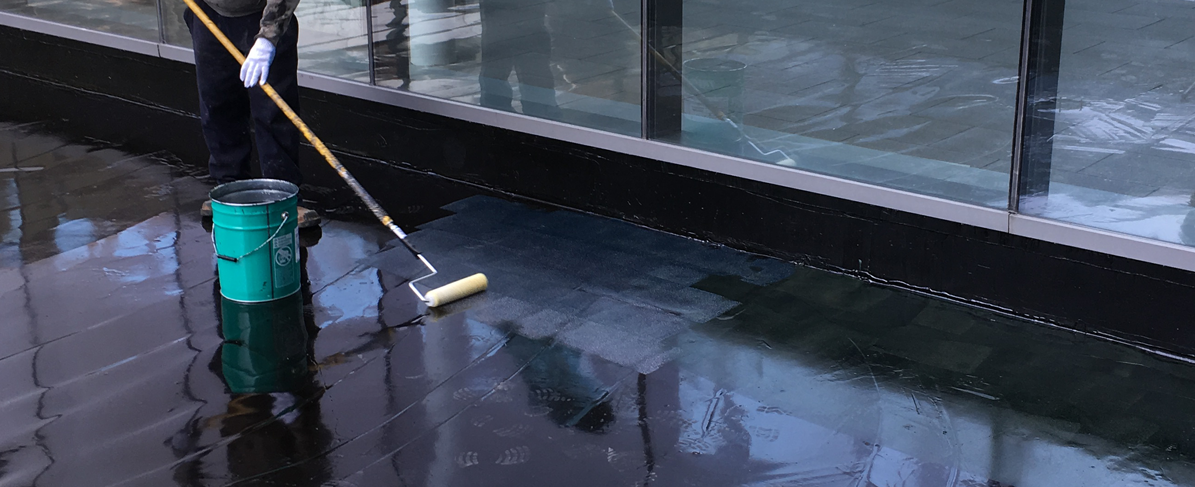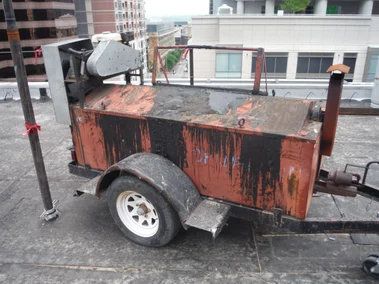Cold vs. Hot-Applied Liquid Waterproofing Membranes
Is hot-applied or cold-applied waterproofing best for your project? Here are the similarities and differences in terms of chemistry, performance, labor, and time.

Is hot-applied or cold-applied waterproofing best for your project? Here are the similarities and differences in terms of chemistry, performance, labor, and time.

For horizontal waterproofing in new construction or renovation projects, there are countless fluid-applied membranes in the market. To simplify the selection process, you can break down these liquid waterproofing technologies into two main categories: hot-applied and cold-applied waterproofing.
In regard to non-exposed conditions, hot- and cold-applied coatings create a seamless, monolithic membrane to protect balconies, terraces, plaza decks, planters, covered podiums, green or vegetated roofs, and more from water infiltration and leaks.
To determine which technology is best for your project, let’s look at the similarities and differences between hot- and cold-applied waterproofing in terms of their chemistry, overall performance, labor, and time.
In comparing cold and hot applied products in terms of labor savings, you’ll want to look at not just the number of people or number of hours needed, but also the complexity and the safety of the application.
Hot-applied waterproofing, like Tremco's TREMproof® 6100, requires the use of a large, heavy kettle or melter with an open flame and flammable gases to heat the material to the appropriate temperature, upwards of 425°F (218°C). The extreme heat leads to obvious safety concerns for the danger of combustion and burns. In addition, for applications on high elevations like plaza decks and roofs, cranes or lifts are necessary to hoist the kettle or melter up to the site, posing additional risks. Because of this, local building codes and fire marshals have varying restrictions to when, where, and how these materials can be used.
HRA can produce a strong odor that may disturb nearby occupants, which can be especially problematic for adjacent hospitals, schools, and offices. Complaints from these facilities can slow down your project significantly.
Cold-applied materials, on the other hand, are low-odor and do not require as much equipment. The smaller pails of materials can be carried across the jobsite by hand and on elevators or stairs to the necessary elevation. No heating mechanisms are required so given proper storage ahead of the application, the product simply needs to be mixed and then sprayed or roll-applied. Some systems necessitate several coats of different membranes while others only need a single lift.
Timing is critical for waterproofing jobs and involves more than just how long it takes to apply a particular product. You also need to consider substrate and material preparation, product application, curing, and clean up. Given the sequencing of trades in new construction, the waterproofing needs to be completed before other steps of the building can begin. With existing structures, owners will want the area returned to service as quickly as possible, especially in an emergency situation with a short window of time to make the repair.
To start, the substrate, which is typically concrete, has to be ready for the waterproofing material. Most hot-applied technologies require that the concrete has cured for at least 28 days before application. However, most cold-applied systems can go down on damp and “green” concrete, which has set but not fully cured. Some products, such as TREMproof 250GC, can be applied 24 hours after the removal of the concrete form. This means that a cold-applied job can begin several weeks sooner than one opting for a hot-applied product.
Weather conditions and time of year can also impact which solution is best. When installing any fluid-applied membrane in warm temperatures, there is a risk of the material bubbling as air tries to escape to the surface, causing unsightly blisters and pinholes that inhibit the waterproofing performance of the system. Be sure to speak with the product manufacturer for insights on how to prevent and remediate this challenge.
Hot-applied systems can typically be applied in lower temperatures than cold-applied systems. These can be installed in conditions as low as 25°F (-3.8°C) whereas cold-applied systems are recommended above 40°F (5°C). In cold climates, a hot-applied solution could prevent you from having to wait days or weeks until the temperature rises.
On the other hand, kettles or melters take 2-3 hours to heat the material to the right temperature and typically require a primer and reinforcing fabric which can extend installation times. Cold-applied waterproofing membranes can go down right after mixing and many have primerless adhesion and do not need reinforcing fabric.
In terms of the product application itself, it is estimated that a four-person crew can install about 2,000 sq. ft. of HRA in a day. A comparable team of installers can apply 10,000 sq. ft. of cold-applied coatings in a day. This makes the installation of cold-applied waterproofing 5 times faster than hot-applied.
The curing process follows a similar trend. Some cold-applied membranes can cure and be traffic-ready within 3 hours, with many hot-applied systems taking 24 hours or more.
Hot-applied and cold-applied waterproofing technologies have their pros and cons depending on the project application, environmental conditions, necessary turnaround time, and other factors. For more details, review Tremco’s Below-Grade Waterproofing Brochure here.